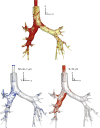Aerosol delivery via invasive ventilation: a narrative review
- PMID: 33987286
- PMCID: PMC8105868
- DOI: 10.21037/atm-20-5665
Aerosol delivery via invasive ventilation: a narrative review
Abstract
In comparison with spontaneously breathing non-intubated subjects, intubated, mechanically ventilated patients encounter various challenges, barriers, and opportunities in receiving medical aerosols. Since the introduction of mechanical ventilation as a part of modern critical care medicine during the middle of the last century, aerosolized drug delivery by jet nebulizers has become a common practice. However, early evidence suggested that aerosol generators differed in their efficacies, and the introduction of newer aerosol technology (metered dose inhalers, ultrasonic nebulizer, vibrating mesh nebulizers, and soft moist inhaler) into the ventilator circuit opened up the possibility of optimizing inhaled aerosol delivery during mechanical ventilation that could meet or exceed the delivery of the same aerosols in spontaneously breathing patients. This narrative review will catalogue the primary variables associated with this process and provide evidence to guide optimal aerosol delivery and dosing during mechanical ventilation. While gaps exist in relation to the appropriate aerosol drug dose, discrepancies in practice, and cost-effectiveness of the administered aerosol drugs, we also present areas for future research and practice. Clinical practice should expand to incorporate these techniques to improve the consistency of drug delivery and provide safer and more effective care for patients.
Keywords: Invasive mechanical ventilation; aerosol therapy; inhaled drugs; lung deposition.
2021 Annals of Translational Medicine. All rights reserved.
Conflict of interest statement
Conflicts of Interest: All authors have completed the ICMJE uniform disclosure form (available at http://dx.doi.org/10.21037/atm-20-5665). The series “Medical Aerosol in Acute and Critical Care” was commissioned by the editorial office without any funding or sponsorship. JBF served as the unpaid Guest Editor of the series and is Chief Science Officer for Aerogen Pharma Corp. The authors have no other conflicts of interest to declare.
Figures




References
-
- Fink JB, Ari A. Aerosol therapy in mechanically ventilated patients. ISAM Textbook of Aerosol Medicine. Rochelle, NY: International Society of Aerosols in Medicine (ISAM)/Mary Ann Libert Publishing, Inc., 2015:947-86.
-
- Altobelli N. Airway management. In: KacMarek RM, Stoller JK, Heuer AJ, editors. Egan's Fundamentals of Respiratory Care 11th ed. St. Louis, MO: Elsevier-Mosby 2017:749-52.
Publication types
LinkOut - more resources
Full Text Sources
Other Literature Sources
